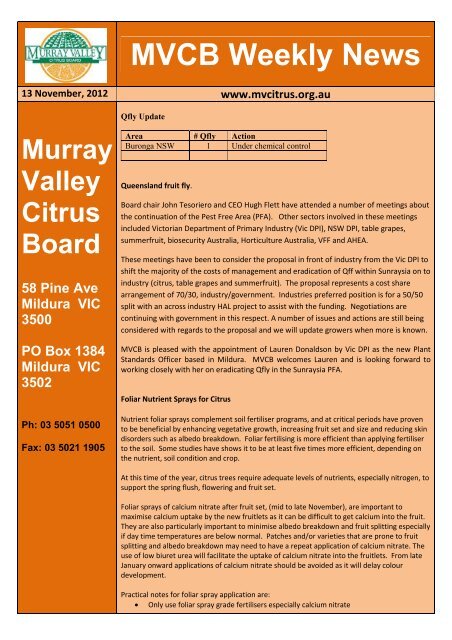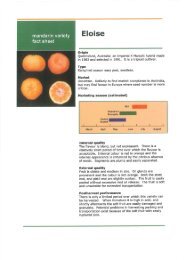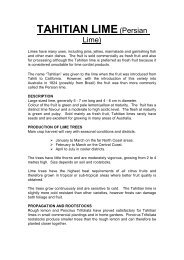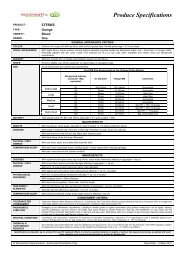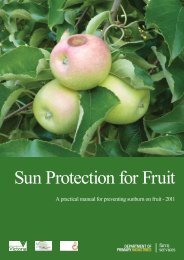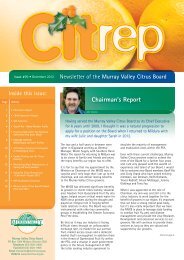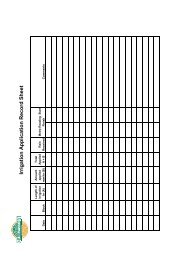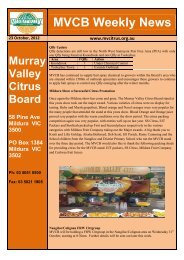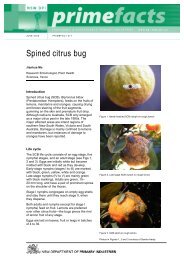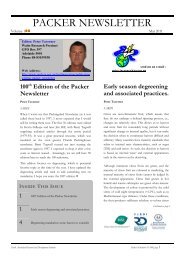MVCB Weekly News - Murray Valley Citrus Board
MVCB Weekly News - Murray Valley Citrus Board
MVCB Weekly News - Murray Valley Citrus Board
Create successful ePaper yourself
Turn your PDF publications into a flip-book with our unique Google optimized e-Paper software.
<strong>MVCB</strong> <strong>Weekly</strong> <strong>News</strong><br />
13 November, 2012 www.mvcitrus.org.au<br />
<strong>Murray</strong><br />
<strong>Valley</strong><br />
<strong>Citrus</strong><br />
<strong>Board</strong><br />
58 Pine Ave<br />
Mildura VIC<br />
3500<br />
PO Box 1384<br />
Mildura VIC<br />
3502<br />
Ph: 03 5051 0500<br />
Fax: 03 5021 1905<br />
Qfly Update<br />
Area # Qfly Action<br />
Buronga NSW 1 Under chemical control<br />
Queensland fruit fly.<br />
<strong>Board</strong> chair John Tesoriero and CEO Hugh Flett have attended a number of meetings about<br />
the continuation of the Pest Free Area (PFA). Other sectors involved in these meetings<br />
included Victorian Department of Primary Industry (Vic DPI), NSW DPI, table grapes,<br />
summerfruit, biosecurity Australia, Horticulture Australia, VFF and AHEA.<br />
These meetings have been to consider the proposal in front of industry from the Vic DPI to<br />
shift the majority of the costs of management and eradication of Qff within Sunraysia on to<br />
industry (citrus, table grapes and summerfruit). The proposal represents a cost share<br />
arrangement of 70/30, industry/government. Industries preferred position is for a 50/50<br />
split with an across industry HAL project to assist with the funding. Negotiations are<br />
continuing with government in this respect. A number of issues and actions are still being<br />
considered with regards to the proposal and we will update growers when more is known.<br />
<strong>MVCB</strong> is pleased with the appointment of Lauren Donaldson by Vic DPI as the new Plant<br />
Standards Officer based in Mildura. <strong>MVCB</strong> welcomes Lauren and is looking forward to<br />
working closely with her on eradicating Qfly in the Sunraysia PFA.<br />
Foliar Nutrient Sprays for <strong>Citrus</strong><br />
Nutrient foliar sprays complement soil fertiliser programs, and at critical periods have proven<br />
to be beneficial by enhancing vegetative growth, increasing fruit set and size and reducing skin<br />
disorders such as albedo breakdown. Foliar fertilising is more efficient than applying fertiliser<br />
to the soil. Some studies have shows it to be at least five times more efficient, depending on<br />
the nutrient, soil condition and crop.<br />
At this time of the year, citrus trees require adequate levels of nutrients, especially nitrogen, to<br />
support the spring flush, flowering and fruit set.<br />
Foliar sprays of calcium nitrate after fruit set, (mid to late November), are important to<br />
maximise calcium uptake by the new fruitlets as it can be difficult to get calcium into the fruit.<br />
They are also particularly important to minimise albedo breakdown and fruit splitting especially<br />
if day time temperatures are below normal. Patches and/or varieties that are prone to fruit<br />
splitting and albedo breakdown may need to have a repeat application of calcium nitrate. The<br />
use of low biuret urea will facilitate the uptake of calcium nitrate into the fruitlets. From late<br />
January onward applications of calcium nitrate should be avoided as it will delay colour<br />
development.<br />
Practical notes for foliar spray application are:<br />
• Only use foliar spray grade fertilisers especially calcium nitrate
Diary Dates:<br />
• Alternatively use chelated forms of magnesium, zinc, calcium or manganese for foliar<br />
sprays<br />
• Do not apply foliar sprays in high temperatures (above 32 0 C) especially if humidity is<br />
low or trees are stressed<br />
• Check pH and conductivity. Optimum pH if there is no fruit on trees is between 5.0<br />
and 5.5. If fruit is present optimum pH is between 5.5 and 6.0. Electrical conductivity<br />
should be below 15,000<br />
• Use between 2,000 and 3,000 L/ha volume of water.<br />
For more information contact your agronomist or chemical reseller


